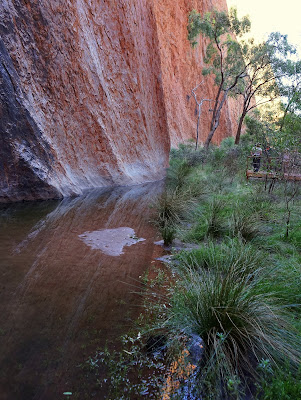Astronomy
Yulara is a resort owned and run by Voyages. But there are a range of different activities
available. The resort, in
partnership with the ARC Centre of Excellence for All-sky Astrophysics
(CAASTRO), plays host to the Uluru Astronomy Weekend annually. Fortunately for
us (with a bit of planning along the way) we had arrived for the 2017 event.
Hosted by Associate Professor Lisa Harvey-Smith, along with
some of the world’s leading experts, the weekend included engaging discussions
on the structure of the Universe, dark
matter, fun family activities and
demonstrations. This was a marriage made
in heaven for our boys – nature, adventure and SCIENCE. Over the next two days we took in the
following talks/activities although there were many more to do (especially if
you don’t have boys who can’t stay up until midnight).
TRADITIONAL INMA WELCOME TO COUNTRY Senior Anangu elders and young
performers offer you the privilege to share in a traditional Inma including
song and dance.
HOW DID THE UNIVERSE BEGIN? All
scientific experts agree on the Big Bang. The burning question around the world
remains ‘what happened after that?’ MC and Assoc. Prof. Lisa Harvey-Smith
adjudicates a lively debate on this hotly contested topic with our guest
astronomers.
PLANETS IN BOTTLES
Assoc. Prof. Tara Murphy will give kids big and small an interactive
introduction to Astronomy with each participant making their own planet inside
a bottle to simulate its conditions and
see if life will flourish.
ABORIGINAL ASTRONOMY &
NAVIGATION Prof. Ray Norris explores the Aboriginal
astronomical stories and traditions and reveals how they were used for
practical purposes such as navigation.
BLACK HOLES IN THE DISTANT
UNIVERSE Join
Prof. Elaine Sadler as she discusses how black holes become ‘active’ and the
extraordinary symbiosis between black holes and their parent galaxies - shaping
the galaxies we see around us today.
So if you would like to know a bit about the latest theories of
how black holes control star formation, how the universe is expanding and about
the stars, Aboriginal dreaming and Song Lines etc, I have 2 boys that would
love to share their learnings with you.
There was also a didgeridoo workshop. We had known already from previous tours that the didgeridoo is not used across Australia and was not used by the indigenous people near here. But the talk was still informative and the boys loved having a go themselves.
One of the best activities we did was the Maruku Arts Dot
Painting Workshop. We did a morning
session with a lovely Pitjantjatjara artist called Sarah who introduced us to
some Tjukupa (Creation Time symbols) and talked about her painting. We then had to try painting a story or
journey ourselves. The boys both did two
paintings, I just did the one (being a bit more meticulous and slower). We all loved this workshop and even now we
are back at home, the boys love showing off their creations.
Mine is on the bottom right (our journey from Canberra to
Boodjuammula, Artilla, Uluru and Tkata Juta, Mr L is left of mine (our journey
from Canberra to Newcastle and then Uluru) and the one above (his version of a
story of the first rain coming from the stars(, Mr Cs are directly above his
(the two serpents) and then next one on the right (Emu Dreaming from his
astronomy talk).
Field of
Lights
We gave the kids some choices about what we would do and what we
would spend money on while at Uluru. Their
first choice – the Star Pass trip to the Field of Lights. We were picked up from our campground and
transported to a red sand dune. Here we
were standing in the heart of the red desert, the last rays of the sun playing
on the amazing icon that is Uluru in front of us. As darkness descended over the red dirt
covered with spinifex and desert oaks, the dark valley floor beneath us began
to light up. Our experience was improved
with the drinks and canapes (albeit more drinks than canapes) that we were
indulging in while waiting – waiting for the dark to come.
Then they started, slowly at first, it was hard to tell if they
were lit. What am I talking about – the
50,000 solar powered bulbs carpeting the ground before us. Before long though we could see, there it was
in its coloured glory – the Field of Lights.
When dark has arrived you descend down a lit path to walk among
the ever changing painting of light that surrounded us.
We were supposed to be back at the bus stop in 45 minutes – we
missed it. There was too much to see,
too much to walk through to do it justice in 45 minutes. Fortunately, the tour operators understood
this and ran buses back to the Yulara until much later at night. Our photos don’t do the magic of the night
justice (you aren’t allowed a tripod in the Field of Lights so we didn’t have
ours). It was Mr C’s idea that brought
us these photos instead of coloured blurs.
He realised that what you needed to do was not focus on the bulb but on
the cable. Thanks to him we have some
pretty cool shots.
This magic night was one of the highlights of our whole trip. On the way back in the bus Mr L was already
planning an installation at home – he thought he might start small, just glow
sticks for now.
































